How to Write a Resume in LaTeX
Sample Resume and LaTeX Code
 Sample LaTeX Resume
Sample LaTeX Resume LaTeX Resume Template
LaTeX Resume TemplateMethod 1 of 7:
Writing a Resume in LaTeX
-
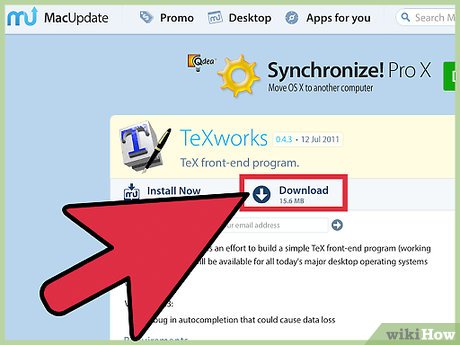 The first step is to download a free copy of a LaTeX editor. Although any LaTeX editor should work. This article is written specifically for TeXworks.
The first step is to download a free copy of a LaTeX editor. Although any LaTeX editor should work. This article is written specifically for TeXworks. -
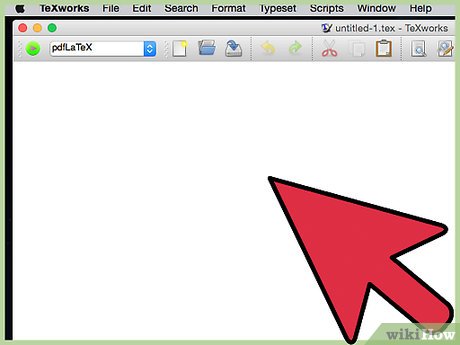 When you open up Tex Works you should see a screen like this:
When you open up Tex Works you should see a screen like this: -
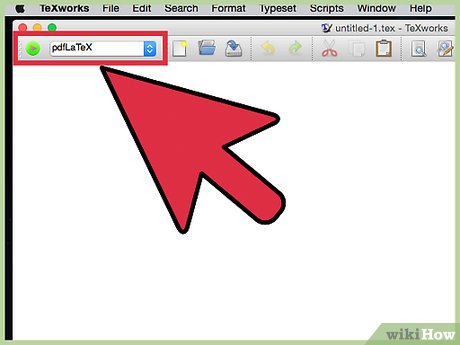 Change the top left menu to pdfLaTeX: I also would suggest going into Format/Syntax Highlighting and selecting LaTeX, as this will make your code easier to read.
Change the top left menu to pdfLaTeX: I also would suggest going into Format/Syntax Highlighting and selecting LaTeX, as this will make your code easier to read.
Method 2 of 7:
Set Up the Document
- In LaTeX, you have to set up each of the margins manually, which can seem tedious at first. However if you have too much information or too little, these settings can be easily adjusted to make your document look its best. This can be done with the following code:
documentclass[11pt]{article} %Sets the default text size to 11pt and class to article. %------------------------Dimensions-------------------------------------------- topmargin=0.0in %length of margin at the top of the page (1 inch added by default) oddsidemargin=0.0in %length of margin on sides for odd pages evensidemargin=0in %length of margin on sides for even pages textwidth=6.5in %How wide you want your text to be marginparwidth=0.5in headheight=0pt %1in margins at top and bottom (1 inch is added to this value by default) headsep=0pt %Increase to increase white space in between headers and the top of the page textheight=9.0in %How tall the text body is allowed to be on each page 
Method 3 of 7:
Begin the Document
- The next step is to actually begin your document. In LaTeX this is done by simply inserting the following code:
begin{document} end{document} %These two pieces of code tell LaTeX that everything that goes in between these tags is what you want displayed as your actual document. 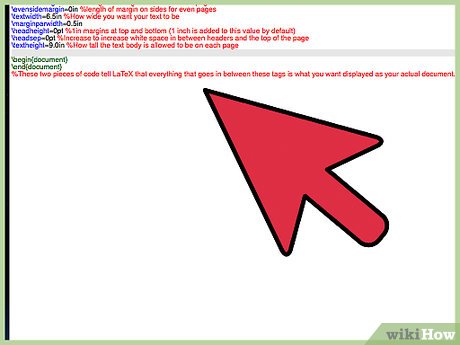
Method 4 of 7:
Make the Header
- In LaTeX you write your document in the same manner that would would in Word, except you have to use commands like:
centerline{} %Makes whatever text you put in parenthesis move to the center noindent %Prevents the following text from being indented large, Large, LARGE %Make the following text larger (each one is a bigger font) %This is the same as a return in Latex 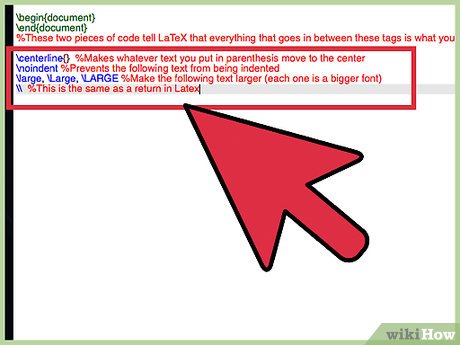
-
 The return key also plays a key role in designing LaTeX documents. If you return twice as if to make a new paragraph, LaTeX will treat that as a new paragraph and ignore any formatting code used for the previous paragraph. We will see how this comes in handy later.
The return key also plays a key role in designing LaTeX documents. If you return twice as if to make a new paragraph, LaTeX will treat that as a new paragraph and ignore any formatting code used for the previous paragraph. We will see how this comes in handy later. -
 At this point your document should look like this:
At this point your document should look like this:
Method 5 of 7:
Making the Body
- The next part of your resume should be some simple objective and summary type sections. This can easily be accomplished by making headers and following them with text. Here is an example:
noindent {Large bf Objective} %don't indent this line and make it bold and large smallskip %This creates a small gap but not quite as large as a return (it's a space saver) noindent %This is to make the following text not indented %Here is where you would put your text. In order for the noindent to take effect your text must be directly below the command. There cannot be a line gap between the command and your text (shown in picture below) bigskip %This makes a large line skip (smallskip is also a command but has a smaller gap noindent{Large bf Executive Summary} smallskip noindent %Here is again where you would put your text (again directly below the noindent command) 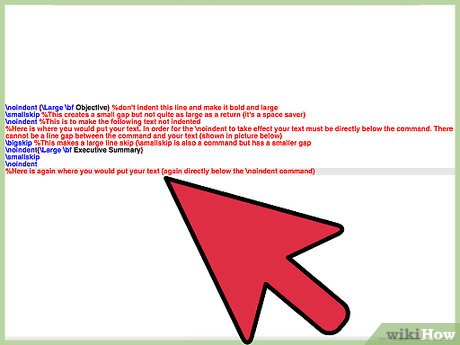
-
 Below are examples of how your text should look in LaTex and how your document should look so far:
Below are examples of how your text should look in LaTex and how your document should look so far:
Method 6 of 7:
Extra Helpful Commands
- While this may look a little bit silly on the sample resume we created, it serves the purpose of demonstrating how you can make columns in LaTeX. In order to do a list of known programming languages I used the following command:
hfill %This command will create even spacing between whatever you put it in between (text and margin, text and text, etc.) 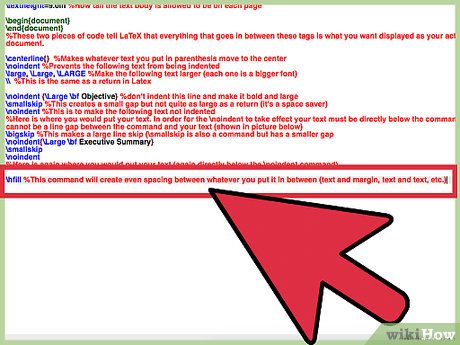
- Here is a sample of hfill using the following code:
noindent %Make sure that there is no line skip for as long as you want this effect Can Program in a large variety of languages including: %The is the same as a return centerline{hfill $bullet$ C++ hfill $bullet$ Python hfill $bullet$ Perlhfill} centerline{hfill $bullet$ Bash hfill $bullet$ IDL hfill} Proficient with the following engineering applications: centerline{hfill $bullet$ MatLab hfill $bullet$ Solid Works hfill $bullet$ EES hfill} noindent{Large bf Professional Experience} smallskip centerline{ {large bf Laboratory for Atmospheric and Space Physics hfill 2011 Present} } $bullet$ Mission Operations and Subsystem Analysis $bullet$ Analysis of the SORCE and AIM Power Subsystems $bullet$ Analysis of the TIM SORCE Instrument and QSCAT Scatterometer bigskip 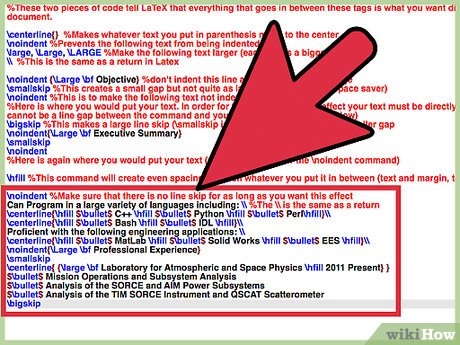
-
 Repeat these last 4 lines for each section you want to add.
Repeat these last 4 lines for each section you want to add. - Here is a look at the code and the product after you add in these lines:
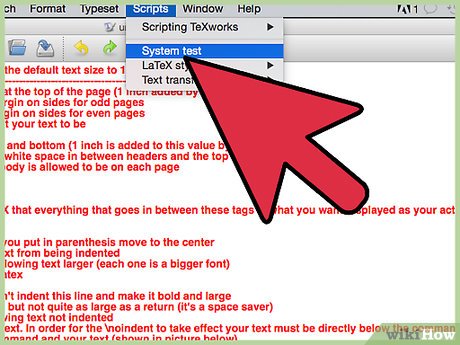
Method 7 of 7:
Finishing Up
- Now all you need to do to finish the resume is add in more sections (using the same steps show above), tweak your dimensions, and it never hurts to have a professional look at it to make sure you did a good job. I hope this is helpful to whoever decides to use it, and I hope it will inspire more people to start learning LaTeX as it can be a great skill to have.
3.5 ★ | 2 Vote
You should read it
May be interested
- Instructions to enable Resume feature in Windows 11
 the resume feature in windows 11 lets you open a onedrive file on your phone and continue working on your computer through your 1 microsoft account.
the resume feature in windows 11 lets you open a onedrive file on your phone and continue working on your computer through your 1 microsoft account. - How to Install LaTeX Fonts on Mac OS X
 latex fonts are high quality members of a family of fonts referred to as 'computer modern.' these fonts allow the author greater control and precision when typing mathematical and technical documents. installing latex is great for teachers...
latex fonts are high quality members of a family of fonts referred to as 'computer modern.' these fonts allow the author greater control and precision when typing mathematical and technical documents. installing latex is great for teachers... - 8 mistakes should be avoided when writing a CV
 cv (curriculum vitae), also called a resume, is a bridge to help you get closer to employers. if you want to impress them before entering the interview, you need to write a perfect cv and especially avoid the following 8 basic mistakes.
cv (curriculum vitae), also called a resume, is a bridge to help you get closer to employers. if you want to impress them before entering the interview, you need to write a perfect cv and especially avoid the following 8 basic mistakes. - The secret of writing professional English CV
 the basics to note about the form of the cv, how to use keywords, english verbs and many other interesting things to highlight the resume.
the basics to note about the form of the cv, how to use keywords, english verbs and many other interesting things to highlight the resume. - How to Write About Your Hobbies and Interests
 the interests and hobbies section of a resume or college application provides a good opportunity to showcase your personality. a well-executed one can even compensate for a lack in experience or education. although you might think that all...
the interests and hobbies section of a resume or college application provides a good opportunity to showcase your personality. a well-executed one can even compensate for a lack in experience or education. although you might think that all... - How to Create a Professional Resume in Google Docs
 google docs makes it easier than ever to create a professional-looking resume. here's how to create a professional resume in google docs.
google docs makes it easier than ever to create a professional-looking resume. here's how to create a professional resume in google docs. - How to Get Started Using LaTeX
 latex is a great program for writing in the scientific and mathematical disciplines. it allows you to make clean, well formatted pdfs, perfect for submission to academic journals or for reports. anyone who needs to type equations should...
latex is a great program for writing in the scientific and mathematical disciplines. it allows you to make clean, well formatted pdfs, perfect for submission to academic journals or for reports. anyone who needs to type equations should... - Simple tips to help optimize your job search resume
 in an increasingly competitive labor market, to help employers distinguish between you and a crowd of applicants, you need to spend time tailoring your resume to suit each different job.
in an increasingly competitive labor market, to help employers distinguish between you and a crowd of applicants, you need to spend time tailoring your resume to suit each different job. - How to 'Resume download' when downloading files is interrupted in Google Chrome
 it's annoying to be downloading a large file that the internet connection naturally gets lost. however, with google chrome, you can continue to download (resume) if internet connection interruption occurs.
it's annoying to be downloading a large file that the internet connection naturally gets lost. however, with google chrome, you can continue to download (resume) if internet connection interruption occurs. - How to create a resume with Canva
 creating a resume is an easy task. canva is a useful tool that can help you do this.
creating a resume is an easy task. canva is a useful tool that can help you do this.
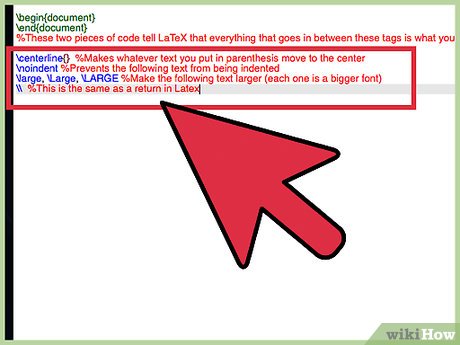
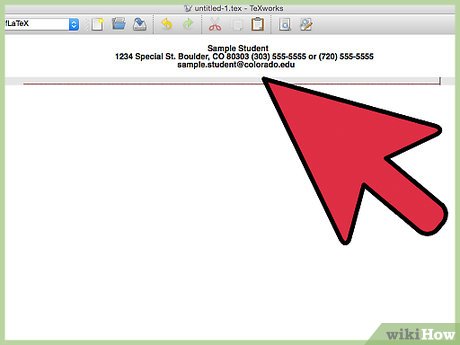

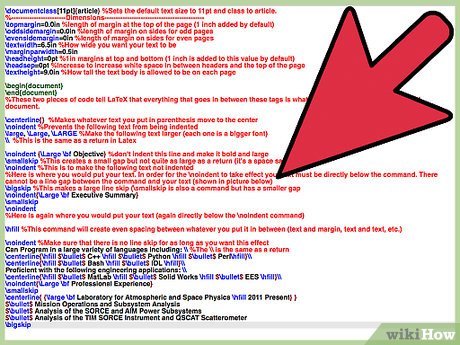







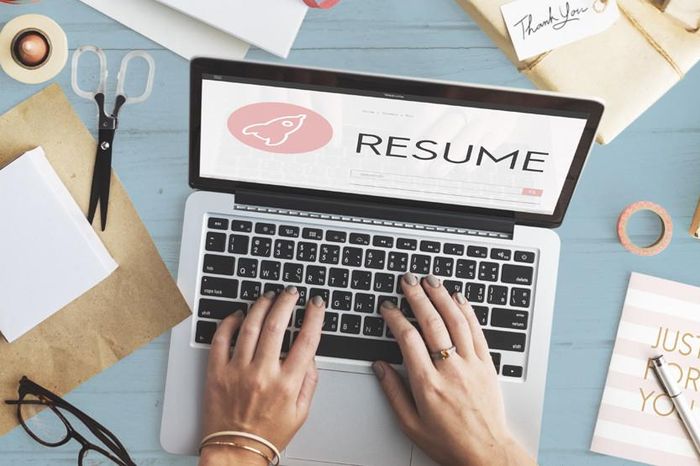


 How to Program Software
How to Program Software How to Program in Fortran
How to Program in Fortran How to Execute HTTP POST Requests in Android
How to Execute HTTP POST Requests in Android How to Make a Cube in OpenGL
How to Make a Cube in OpenGL How to Create a Mobile App
How to Create a Mobile App How to Download, Install, and Use Code::Blocks
How to Download, Install, and Use Code::Blocks